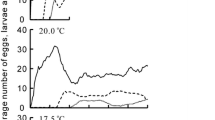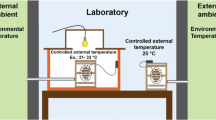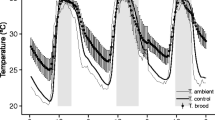Abstract
For Lasius japonicus Santschi (Hymenoptera: Formicidae), a common ant species in Japan, diapause induction is temperature dependent. To elucidate the geographic variation of its temperature dependence, new L. japonicus queens were collected immediately after nuptial flight from four sites at different latitudes: Kitami (44.1°N), Hakodate (41.8°N), Shizuku-ishi (39.7°N), and Okayama (34.7°N). The collected queens were reared for 100 days at four constant-temperature conditions (25 °C, 20 °C, 17.5 °C, and 15 °C) under a 12L:12D photoperiod. The queens began founding colonies immediately in all conditions. For all temperature conditions, daily change patterns of the average numbers of eggs, larvae, and pupae were similar among the Hakodate, Shizuku-ishi, and Okayama populations, but the development patterns of the Kitami colonies differed from those of the other three sites. Low temperatures strongly suppressed colony development of the Kitami population; development was weak even at moderate temperatures. For new queens of L. japonicus, solitary overwintering without rearing larvae is regarded as serving an important role in successful colony foundation under cool climate conditions. Results reported herein suggest that local temperatures exert important selective pressure on the timing of diapause induction and on colony development in northern populations.





Similar content being viewed by others
References
Beck SD (1980) Insect photoperiodism, 2nd edn. Academic Press, New York, p 387
Bradshaw WE, Holzapfel CM (2007) Evolution of animal photoperiodism. Annu Rev Ecol Evol Syst 38:1–25
Carton Y, Claret J (1982) Adaptative significance of a temperature induced diapause in a cosmopolitan parasitoid of Drosophila. Ecol Entomol 7:239–247
Danilevskii AS (1961) Photoperiodism and seasonal development of insects. (Translated by Hidaka T, Masaki S in 1966 from the Russian edition, Leningrad University Press, Leningrad.) University of Tokyo Press, Tokyo (in Japanese)
Danks HV (1987) Insect dormancy: an ecological perspective. Biological survey of Canada monograph series no. 1
Denlinger DL (2009) Diapause. In: Resh VH, Cardé RT (eds) Encyclopedia of insects, 2nd edn. Academic Press, San Diego, pp 267–271
Gotoh T, Kameyama Y (2014) Low temperature induces embryonic diapause in the spider mite, Eotetranychus smithi. J Insect Sci 14:1–8
Ito K, Nakata T (2000) Geographical variation of photoperiodic response in the females of a predatory bug, Orius sauteri (Poppius) (Heteroptera: Anthocoridae) from northern Japan. Appl Entomol Zool 35:101–105
JADG (Japanese Ant Database Group) (2003) Ants of Japan. Gakken, Tokyo, 196 pp. (in Japanese)
Kamitani S, Asakura K, Nakamura K (2015) Effects of environmental factors on life cycle regulation in Lasius japonicus Santschi (Formicidae). Sociobiology 62:467–473
Kipyatkov VE (1993) Annual cycles of development in ants: diversity, evolution, regulation. Proc Colloq Soc Insects 2:25–48
Kipyatkov VE (2001) Seasonal life cycles and the forms of dormancy in ants (Hymenoptera: Formicoidea). Acta Soc Zool Bohem 65:211–238
Kipyatkov VE (2006) The evolution of seasonal cycles in cold-temperate and boreal ants: patterns and constraints. In: Kipyatkov VE (ed) Life cycles in social insects: behaviour, ecology and evolution. St. Petersburg University Press, St. Petersburg, pp 63–84
Kipyatkov VE, Lopatina EB (1993) The regulation of annual cycle of development in the ants of the subgenus Serviformica (Hymenoptera, Formicidae). Proc Colloq Soc Insects 2:49–60
Kipyatkov VE, Lopatina EB (2002) Reaction norm in response to temperature may change to adapt rapid brood development to boreal and subarctic climates in Myrmica ants (Hymenoptera: Formicidae). Eur J Entomol 99:197–208
Kipyatkov VE, Lopatina EB, Imamgaliev AA, Shirokova LA (2004) Effect of temperature on rearing of the first brood by the founder females of the ant Lasius niger (Hymenoptera, Formicidae): latitude-dependent variability of the response norm. J Evol Biochem Physiol 40:165–175
Kohno K (1997) Photoperiodic effect on incidence of reproductive diapause in Orius sauteri and O. minutus (Heteroptera: Anthocoridae). Appl Entomol Zool 32:644–648
Kuroki I, Tagawa J, Nakamura K (2018) Endogenous periodicity in egg-number fluctuation in Lasius japonicus (Formicidae). Biol Rhythm Res https://doi.org/10.1080/09291016.2018.1427600
Lees AD (1955) The physiology of diapause in arthropods. Cambridge University Press, London, p 162
Masaki S (1961) Geographic variation of diapause in insects. Bull Fac Agric, Hirosaki Univ 7:66–98
Nakamura K, Fujiyama M, Ohta K (2017) Effect of temperature on queen oviposition and seasonal colony development in Lasius japonicus (Hymenoptera: Formicidae). Appl Entomol Zool 52:107–112
Ohta K, Yuge C, Nakamura K (2017) Effects of photoperiod and light intensity on queen oviposition and colony development in Lasius japonicus (Hymenoptera: Formicidae). Jpn J Appl Entomol Zool 61:17–23 (in Japanese with English abstract)
Schwander T, Humbert JY, Brent CS, Cahan SH, Chapuis L, Renai E, Keller L (2008) Maternal effect on female caste determination in a social insect. Curr Biol 18:265–269
Tauber MJ, Tauber CA, Masaki S (1986) Seasonal adaptations of insects. Oxford University Press, New York, p 426
Zar JH (2010) Biostatistical analysis, 5th edn. Prentice Hall, Upper Saddle River, p 960
Zhang JJ, Desneux N, Benelli G, Zang LS, Du WM, Ruan CC (2017) Geographic variation of diapause induction rates in Trichogramma dendrolimi (Hymenoptera: Trichogrammatidae) in China. J Econ Entomol 110:386–391
Acknowledgements
We thank K. Ohta, M. Fujiyama, T. Ohtsuki, and C. Yuge for helping us in this study. Thanks are also extended to H. Takasaki for manuscript preparation and to M. Natori for statistical advice.
Author information
Authors and Affiliations
Corresponding author
Additional information
Publisher's Note
Springer Nature remains neutral with regard to jurisdictional claims in published maps and institutional affiliations.
Rights and permissions
About this article
Cite this article
Kuroki, I., Tagawa, J. & Nakamura, K. Geographic variation of temperature effects on initial colony development of Lasius japonicus (Hymenoptera: Formicidae). Appl Entomol Zool 54, 175–183 (2019). https://doi.org/10.1007/s13355-019-00610-8
Received:
Accepted:
Published:
Issue Date:
DOI: https://doi.org/10.1007/s13355-019-00610-8




